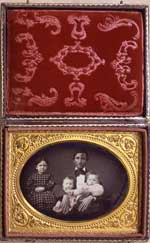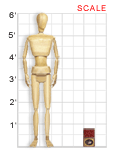From the collection of:
The Kentucky Historical Society || VAM Home
DAGUERREOTYPE OF MILTON HAMILTON AND HIS CHILDREN, BURLINGTON, KY., c. 1840
Photograph, daguerreotype, quarter plate (3.25" X 4.25")
Donated by Elizabeth A. Woodson, 1987ph16.HamiltonDagtp
Courtesy Kentucky Historical Society
Developed by French artist and chemist Louis J.M. Daguerre and introduced in 1839, the daguerreotype was the first patented photographic process. Daguerre’s patent was acquired by the French government, which proclaimed the invention a gift to the world on August 19, 1839.
A daguerreotype is a copper plate with a highly polished silver surface bearing the photo emulsion. There’s no negative; it’s a positive-only process. That means there can be no reproduction—each daguerreotype is unique. These earliest photos took a long time to expose (typically 60 to 90 seconds), so portrait studios were equipped with iron stands and braces that were placed behind subjects’ heads to help them keep perfectly still. That’s one reason most people look very serious in photos of this era. Many people also felt that having a portrait made was a serious endeavor that required a “pose for posterity.”
Though daguerreotypes were the mainstay of photography for only about a decade, the crisp quality and soulful gazes of the subjects make them one of the most aesthetically pleasing portrait forms to this day.
About the Artist
The name of the photographer who took this daguerreotype is not known. The daguerreotype became a commercial sensation almost immediately after its development. Daguerreotypists working in Kentucky in the 1840s included both itinerant photographers and others who set up permanent studios.
Classroom Ideas
Discussion: Before daguerreotypes, how were people’s images captured? How do drawings and paintings compare to photographic images?
What effect would the long exposure time of the daguerreotype have on the subject matter and results? What would happen to the image if the person moved? What age of person might have the most trouble sitting still for a long time?
Compare the facial expressions, poses, clothing, props, and artistic elements of this and other daguerreotypes to later and contemporary photographic portraits. Research the process and science behind creating a daguerreotype, along with subsequent photographic technologies. How has changing technology affected the types of images produced and their role in American life and culture?
Activity: Choose a pose you would like to be photographed in, and then try holding that pose and expression for 60 to 90 seconds. (You could take turns with your classmates, taking photos with a digital or film camera after the time is up.) Discuss how it felt to try to be still for that long and how the resulting photos looked. Display the photos alongside photos taken in a contemporary manner.
Links
America’s First Look Into the Camera, the web site about the Library of Congress daguerreotype collection, includes information about the medium, numerous images, and classroom resources.
[lcweb2.loc.gov/ammem/daghtml/daghome.html]
Numerous daguerreotype images can be found at Harvard University Library’s Daguerreotypes at Harvard site.
[preserve.harvard.edu/exhibits/daguerreotype/intro1.html]
Find out more about the history and process of the daguerreotype and view additional images at the Daguerreian Society.
[www.daguerre.org]
The American Museum of Photography is a virtual museum of thousands of photographs from all periods of photography, arranged by cultural and artistic themes.
[www.photography-museum.com]
Helpful photo analysis worksheets are available from the National Archives and the National Register of Historic Places.
[www.archives.gov/digital_classroom/lessons/analysis_worksheets/photo.html]
[www.cr.nps.gov/nr/twhp/photoana.htm]

